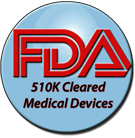Update on Tanning Beds and the FDA 510(k) Submission Process, Contents and Format | Sept 10, 2013 | Lim
May 9th, 2013 // 1:55 am @ marquee
 Exclusive cGMP, FDA and 510(k) Compliance News
Exclusive cGMP, FDA and 510(k) Compliance News
FDA in May 2013 came out with a proposed order that if it is finalized, is going to reclassify tanning beds and related sunlamp products as class II medical devices, and they will require a label that will warn people under 18 to not use such products.
This Webinar will consist of two parts. It first will provide you with an update about the entire tanning bed issue:
- Benefits and risks of using tanning beds, booths, and sunlamps
- Science on tanning beds
- Overview of statute(s) and regulations in the US and other countries
- Labeling on tanning beds
- Practices to avoid
- FDA’s proposed reclassification of tanning beds, booths and sunlamps
- Proposed changes in labeling
- 510(k) submission: contents and format
Second, it will tell you precisely how to prepare and submit a traditional premarket notification 510(k) for successful FDA clearance. The premarket notification 510(k) is the most common pathway to market for medical devices including in vitro diagnostic medical devices (IVDs). If FDA changes its ruling on certain types of medical devices, such as tanning beds which are being reclassified as Class II devices, your medical device company may be required to get a 510(k).
NOTE: If you are interested ONLY in the 510(k) portion of this Webinar, be sure to attend our other event instead: How to Bulletproof Your 510(k) Submission.
What You Will Learn in The FDA 510(k) Portion:
- Applicable statute(s), regulations, and how to interpret them
- Device classification and product codes
- Three types of 510(k)s
- Who is subject to a 510(k) and what actions require a 510(k)
- How to identify a predicate(s), if any – split predicates vs. multiple predicates
- FDA guidance on “Refuse to Accept Policy for 510(k)s,†issued on December 31, 2012.
- FDA guidance on “eCopy Program,†issued on December 31, 2012
- Product type-specific 510(k) contents
- Regulatory requirements in 510(k) submissions.
- How to present scientific, technical, and/or clinical data.
- How to demonstrate substantial equivalence (SE).
- Common 510(k) deficiencies and how to improve 510(k) submission quality.
- Responding to FDA’s request of additional information.
- Speaker’s practical experience and tips
FDA 510(k) Background
Section 510(k) of the Federal Food, Drug, and Cosmetic Act (FD&C Act or the Act) describes the 510(k) requirements. The 510(k) premarket submission is made to US FDA to demonstrate that the subject device (to be marketed) is substantially equivalent (as least as safe and effective) to a legally marketed device (predicate device). In other words, a 510(k) must demonstrate that a proposed product is substantially equivalent to another, legally marketed medical device that is also lower-risk and is not subject to premarket approval (PMA).
Over the years, the 510(k) program has significantly evolved, affecting the 510(k) decision-making process. To expedite the process of bringing a product to market through the 510(k) program, it is imperative the medical device makers understand the recent changes, prepare and submit a quality 510(k) in a way to expedite the review process for fast and successful clearance.
Note: FDA in May 2013 announced that intended to change tanning beds used in indoor tanning salons from class I to class II medical devices. This would require all medical device manufacturers to obtain a 510(k) within one year of the new rule’s effective date.
About Your Speaker:
Dr. David Lim, President and Principal, Regulatory Doctorâ„¢. Regulatory Doctor provides practical, actionable, and sustainable solutions in an integrated, thorough (“PASS-ITâ€) manner. Regulatory Doctor recently authored the article entitled “Demystifying the FDA Appeals Process.â€
Dr. Lim obtained his Ph.D. in biological sciences at the University of Missouri-Columbia and published his thesis research in the prestigious journal “Science.â€Â Since then, Dr. Lim has held various positions at Duke, US National Laboratories, Intrexon Corporation, Terumo, US FDA/CDRH, and EraGen Biosciences, Inc., A Luminex Company. In 2009, Dr. Lim served as a panel member during the FDA’s Transparency Public Meeting. Prior to founding his own consulting firm, Regulatory Doctorâ„¢, Dr. Lim was Senior Vice President of Scientific and Regulatory Affairs at Aquavit Pharmaceuticals, Inc. in New York, wherein Dr. Lim provided inspiring and actionable solutions for sustainable business operation.
Dr. Lim as Regulatory Doctor provides practical, actionable and strategic solutions integrated with emotional intelligence (EQ) skills for all aspects of global regulatory, quality, clinical and compliance matters. Over the years, Dr. Lim has analyzed over 1,500 FDA warning letters including over few thousands of MDRs. Dr. Lim has also attended more than 50 FDA Advisory Panel Meetings and analyzed the subject matters and decision-making processes in detail. Dr. Lim is familiar with more than few hundreds of medical products (medical devices including IVD products, biologics, drugs and combination products). Dr. Lim is a certified professional for regulatory affairs (RAC) and also is a certified quality auditor (CQA) by the American Society for Quality (ASQ). Dr. Lim also is a regulatory coach, mentor, consultant and instructor for global matters pertaining to regulatory affairs, regulatory compliance, quality and clinical affairs.


